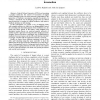6164 search results - page 1102 / 1233 » Environmental Sensor Networks |
NECO
2007
13 years 8 months ago
2007
Learning agents, whether natural or artificial, must update their internal parameters in order to improve their behavior over time. In reinforcement learning, this plasticity is ...
EWSN
2007
Springer
14 years 8 months ago
2007
Springer
Methods for node localisation in sensor networks usually rely upon the measurement of received strength, time-of-arrival, and/or angle-of-arrival of an incoming signal. In this pap...
EWSN
2006
Springer
14 years 8 months ago
2006
Springer
Nodes in a wireless network transmit messages through a shared medium. Thus, a Media Access Control (MAC) protocol is necessary to regulate and coordinate medium access. For some a...
ICRA
2008
IEEE
14 years 3 months ago
2008
IEEE
— Central Pattern Generators (CPGs) are becoming a popular model for the control of locomotion of legged robots. Biological CPGs are neural networks responsible for the generatio...
IPPS
2005
IEEE
14 years 2 months ago
2005
IEEE
We investigate the problem of maximizing the lifetime of wireless ad hoc and sensor networks. Being battery powered, nodes in such networks have to perform their intended task und...

